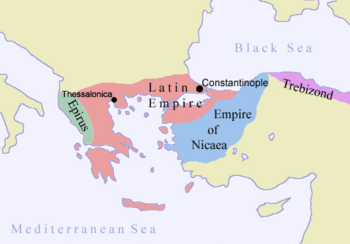Empire of Nicaea facts for kids
Quick facts for kids
Empire of Nicaea
Αυτοκρατορία της Νίκαιας
|
|||||||||
|---|---|---|---|---|---|---|---|---|---|
| 1204–1261 | |||||||||

The Latin Empire, Empire of Nicaea, Empire of Trebizond, and the Despotate of Epirus. The borders are very uncertain.
|
|||||||||
| Capital | Nicaea | ||||||||
| Common languages | Greek | ||||||||
| Religion | Eastern Orthodox Church | ||||||||
| Government | Monarchy | ||||||||
| Emperor | |||||||||
|
• 1204 – 1222
|
Theodore I Lascaris | ||||||||
|
• 1222 – 1254
|
John III Ducas Vatatzes | ||||||||
|
• 1254 – 1258
|
Theodore II Lascaris | ||||||||
| Historical era | High Medieval | ||||||||
|
• Established
|
1204 | ||||||||
|
• Disestablished
|
July 1261 | ||||||||
|
|||||||||
The Empire of Nicaea was a powerful Greek state. It was formed after the city of Constantinople was captured during the Fourth Crusade in 1204. This empire was one of the new states created by leaders from the old Byzantine Empire.
Nicaea became the most important of these new Greek states. Its main goal was to take back Constantinople and bring back the Byzantine Empire. The Empire of Nicaea lasted for 57 years, from 1204 until 1261.
Contents
How the Empire of Nicaea Began
In 1204, knights from Western Europe, known as Crusaders, attacked and captured Constantinople. This city was the capital of the Byzantine Empire. The Crusaders did not return the city to its rightful rulers. Instead, they set up their own state called the Latin Empire.
Many Byzantine leaders and nobles fled Constantinople. They went to different parts of the old empire. One of these leaders was Theodore I Lascaris. He was a son-in-law of the Byzantine Emperor. Theodore went to the city of Nicaea in Asia Minor (modern-day Turkey).
In Nicaea, Theodore Lascaris established a new Greek state. This state quickly grew strong and became known as the Empire of Nicaea. It was seen as the true heir to the Byzantine Empire.
Important Leaders of Nicaea
The Empire of Nicaea had several strong emperors. They worked hard to make their new state powerful and to prepare for taking back Constantinople.
Theodore I Lascaris (1204–1222)
Theodore I Lascaris was the first emperor of Nicaea. He faced many challenges. He had to defend his new empire from attacks by the Latin Empire and other groups. He also worked to make Nicaea a center for Greek culture and learning.
John III Ducas Vatatzes (1222–1254)
John III Ducas Vatatzes was a very successful emperor. He greatly expanded the territory of Nicaea. He won many battles against the Latin Empire and other rivals. Under his rule, Nicaea became the strongest power in the region. He also improved the economy and made the empire wealthy.
Theodore II Lascaris (1254–1258)
Theodore II Lascaris continued his father's work. He was a learned man and focused on education and law. He also kept the empire strong militarily.
Michael VIII Palaeologus (1259–1261)
Michael VIII Palaeologus was the last emperor of Nicaea. He was a clever military leader and politician. He planned the final recapture of Constantinople. He became co-emperor with the young John IV Lascaris.
Taking Back Constantinople
The main goal of the Empire of Nicaea was always to reclaim Constantinople. This dream came true in 1261.
In July 1261, a Nicaean general named Alexios Strategopoulos led a small army. They found an unguarded entrance into Constantinople. The Latin Empire's army was away fighting elsewhere. The Nicaean forces quickly took control of the city.
Michael VIII Palaeologus soon entered Constantinople. He was crowned emperor in the city's main church, the Hagia Sophia. This event marked the end of the Empire of Nicaea. It also meant the Byzantine Empire was restored, though it was smaller and weaker than before.
Legacy of Nicaea
The Empire of Nicaea played a crucial role in Byzantine history. It kept Greek culture and traditions alive during a difficult time. It also provided a base for the Byzantine Empire to be reborn. Its leaders were determined and managed to achieve their ultimate goal: bringing back Constantinople.
Images for kids
-
Nicaea city wall, Lefke gate; Iznik, Turkey
-
Coin issued by Michael VIII Palaeologus to celebrate the liberation of Constantinople from the Latin army, and the restoration of the Byzantine Empire.
See also
 In Spanish: Imperio de Nicea para niños
In Spanish: Imperio de Nicea para niños



